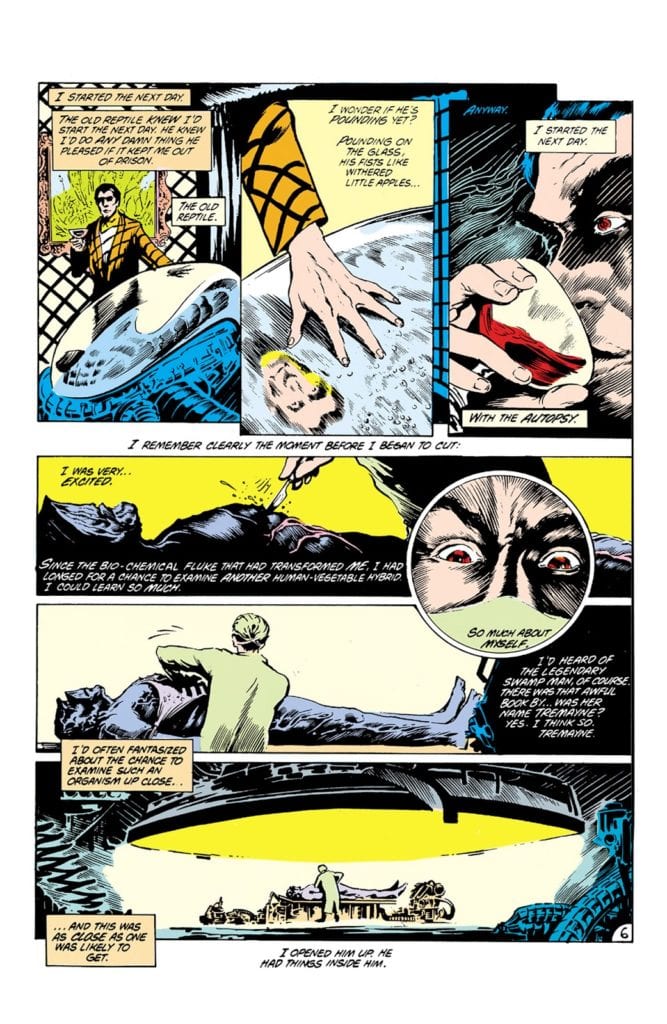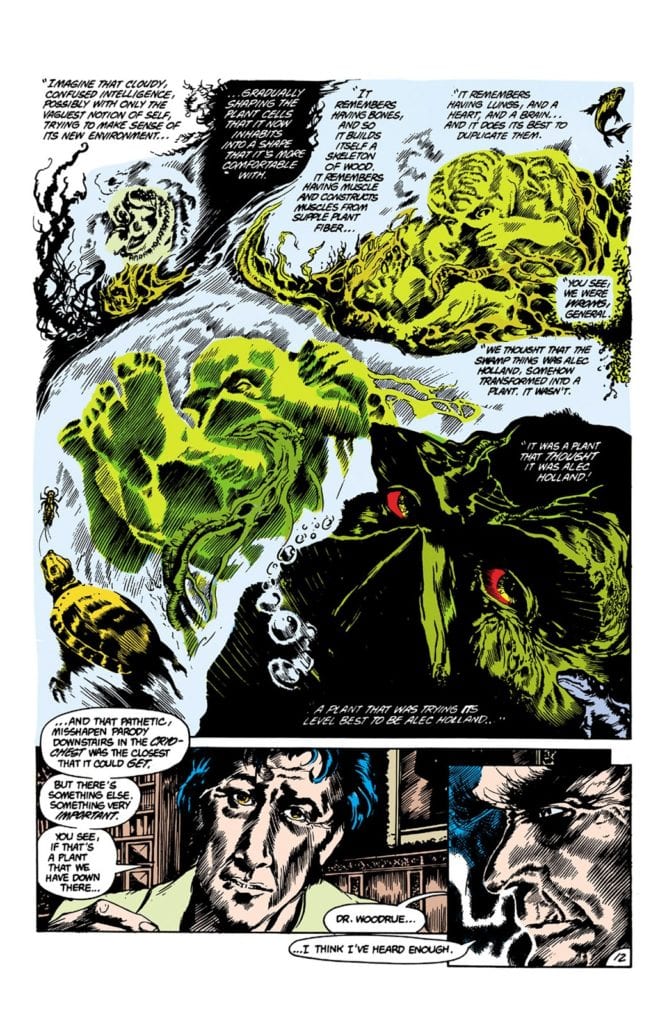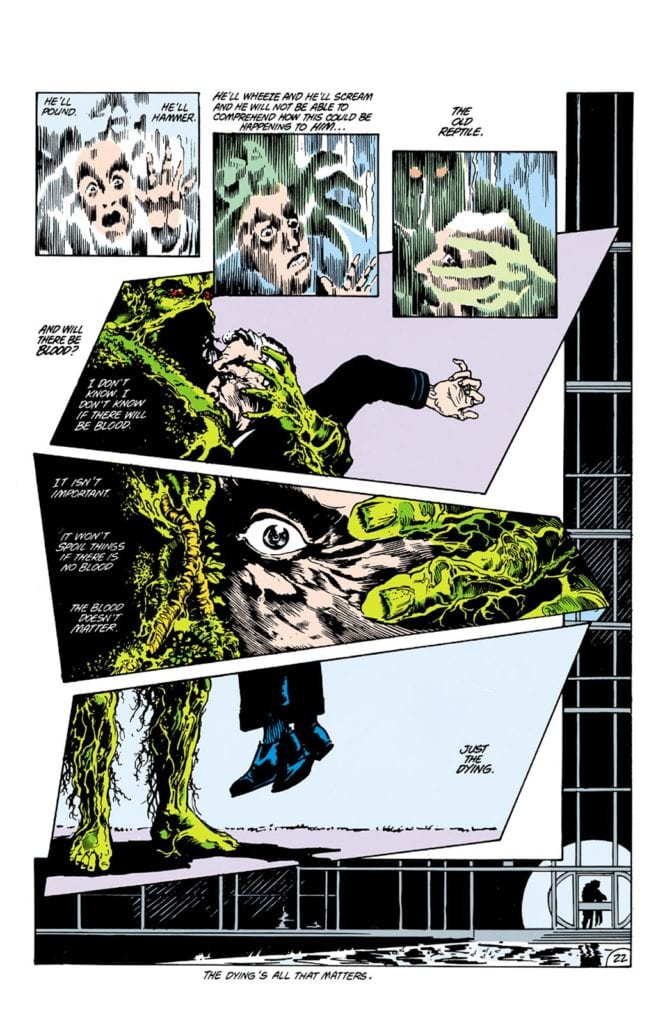Everything runs its course, and even the best of ideas can become stale if they are not given the chance to be re-born. In 1983 DC comics hired a relatively new, up and coming writer to overhaul one of their more obscure horror titles: Swamp Thing.
Just like Neil Gaiman with The Sandman character, Alan Moore was given free reign to do with the comic whatever he wished. The result was a long, 40 plus issue run that not only blended a multitude of genres but, most importantly, made the Swamp Thing a must read comic.
Whatever you think about the later writings of Alan Moore, there is simply no denying that at the start of his career he wrote some of the greatest comics ever published. Watchmen continues to sell thousands of copies every year because it is a seminal work of sequential Art. DC are currently re-releasing The Saga of the Swamp Thing in collected volumes because new, and old, readers still find it as fresh and exciting as it was 36 years ago. Not many comics can make that claim.

Re-Writing The Saga
Alan Moore’s run on Saga of the Swamp Thing started with the often overlooked issue 20. The story was called Loose Ends and as the title suggests Moore uses that issue to address the previous plot lines before launching into his own story.
And launch he does. Issue 21, The Anatomy Lesson, is not only an examination of the central character but a treatise on the way that Moore approaches his projects. In this single issue Moore does something that DC have been trying to do since Crisis on Infinite Earths: he successfully retcon’s a character without dismissing any previous stories. In fact, it’s safe to say that Moore goes one step further and manages to incorporate a plot element that makes all previous versions of the Swamp Thing viable continuity.
The Anatomy Lesson is a physical dissection of the central character used as a metaphor for a larger dissection of the comic’s history. In it Dr Woodrue, the Floronic Man, takes a captured and frozen Swamp Thing and begins to open him up to see how the man inside can survive. What he discovers turns what was becoming a run of the mill superhero into a horror monster of a character. Moore strips away the humanity that was Alec Holland, peeling away the layers step by step and exposing the supernatural core that was to fuel much of Moore’s run.
The process is meticulous. Woodrue delves into everything that makes the swamp monster tick, breaking it down for the reader to see. And this is how Moore builds his stories by first separating out each strand and laying it out for examination. He then examines each individual element, finding its function and purpose before starting to wind it all back together. In The Anatomy Lesson, Swamp Thing is broken into his component parts before slowly reforming to wreak horror upon the people who imprisoned him.
Issue 21 has a Frankenstein feel about it. The obsessive scientist works on an artificial man who in turn becomes fuelled by rage at the truth of his own nature. The essence of Mary Shelley’s gothic horror is there on every page and is embedded into the story itself.

Horrific Visions
No matter how good Moore’s writing is, the comic would not be the masterpiece it is without the artistic talents of Stephen Bissette and John Totleben. The intricate details of the dissection are brought to horrific life by the heavily shadowed inking and focused panels.
Each page is crammed with complex panel layouts which produce the claustrophobic tension necessary to relay the horror of the plot. The moody atmosphere is created in these tight, often abstracted images where the artists pay close attention to small details of the characters to emphasise reactions and emotions.
It’s interesting to note that the panel layouts, like the plot, challenge the concept of how a comic should be perceived. Even on pages where a standard panel layout is used, with a series of stacked panels for example, Bissette and Totleben enjoy playing with the format. They might nudge a panel just below it’s neighbour to create a staggered effect. Often inserts are used that cross two panels, breaking the borders and gutters, linking images and ideas.
For a large part of the comic, however, Bissette and Tutleben use obscurely shaped panels or do away with borders and gutters entirely, merging the images together to create a visual flow of consciousness.The Anatomy Lesson is about challenging the reader and setting a president for the stories that follow.

Tones and Words
I read this originally in a black and white reprint, but if you look at the original color work by Tatjana Wood you can see that even with the limited range scope they had in the 1980’s Wood wanted to set a certain tone beyond recreating a realistic visual. Color is used to indicate character and emotion. The cold blues and natural greens are used to highlight contrast in the plot and identify particular characters.
The horror of the story is brought out with vivid yellows and reds. These hues are unsettling next to the comforting natural colors used for Swamp Thing. This draws the reader deeper into the book and gives us an idea of the turmoil that the central character is experiencing. We, as onlookers, are disgusted and horrified by what we witness.
John Costanza, in turn, gives the lettering a lyrical style, mimicking classic horror novels and the EC style comics from the 1950’s. Moore enjoys loading his comics with text, making it difficult sometimes to display on a page successfully. Constanza does it perfectly by breaking the speeches and narration up into smaller chunks, like the stanzas of a poem. He then places them across the page, leading from one to another with a rhythmic beat. It produces the same feeling as reading Rime of the Ancient Mariner, as if an epic poem has been overlaid onto Hieronymus Bosch artwork.

Conclusion
The important thing to remember about comics like Saga of the Swamp Thing is that they were breaking the moulds of mainstream comics. The Sandman, Animal Man, and a number of other titles that followed all created their own world and their own accents with which to speak.
Swamp Thing began life as a horror comic and the creators behind issue 21 of The Saga of the Swamp Thing majestically brought that concept back in a major way. The story and art are rooted in historical ideals and visions of horror. The conscious move away from Superheroes allows Moore to open up future stories to all sorts of genres as he stamped his mark on American comics.
The Saga of the Swamp Thing changed not only the characters of this comic but also how DC treated different genres within it’s catalogue. After a future issue of Sage was refused the Comic Code Authority seal of approval, DC abandons submitting further issues of Swamp Thing, ultimately leading to the creation of the much loved Vertigo line.
The Sage of the Swamp Thing #21 is an outstanding comic that changed a large part of the comic book world and, without it, so many important comics might not exist today.

